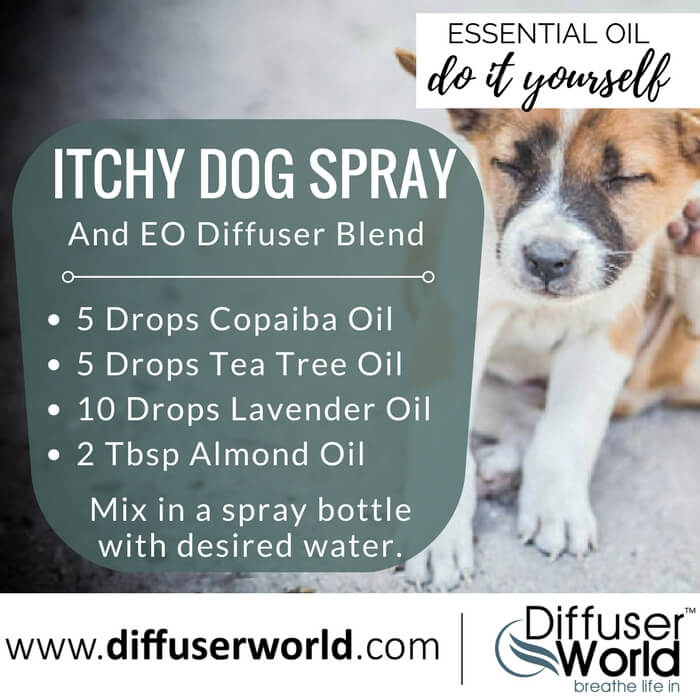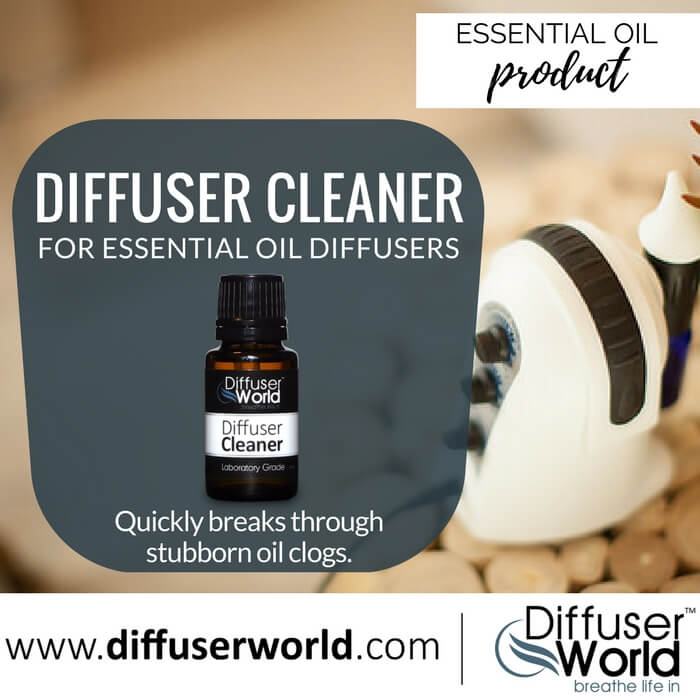Itchy Dog Spray and EO Diffuser Blend

Just like people, dogs often get dry and itchy skin. Soothe minor skin irritations by mixing two tablespoons of almond or coconut oil and 10 drops of lavender essential oil. Massage the oil mixture into skin irritations to help reduce itch, kill bacteria and even calm nerves.
Lavender essential oil is a great analgesic, antifungal, antihistamine, anti-inflammatory and antiseptic. It can be used topically or in a diffuser.
Anti-Itch Spray for Dogs / Diffuser Blend
- 5 Drops Copaiba Oil
- 5 Drops Tea Tree Oil
- 10 Drops Lavender Oil
- 2 Tbsp Almond Oil
Mix in a spray bottle with the desired amount of water
How To Use Aromatherapy With Your Dog
The most popular way to take advantage of aromatherapy is to simply diffuse the scent into a room — or your entire house — allowing you and your dog to breathe in the scent naturally.
You could also place a drop or two of essential oil (mixed first with vegetable oil as a base) directly on your dog’s skin and massage it in — for the fastest results.
How To Use Essential Oils With A Diffuser
With an electric atomizing diffuser, cold diffusion technology preserves the natural essence and complete therapeutic benefits of essential oils by effectively transforming them into a micro-fine vapor without the use of heat or water. These microparticles permeate the air and remain suspended for hours, fully intact, with all of their NATURAL defenses against airborne viruses, bacteria, mold, pests, and odors. Other common uses are respiratory therapy, mood enhancement, relaxation, well being, air purification and more.
Here’s how to use a diffuser with pets:
Apply several drops of essential oils (use the above referenced Itchy Dog Blend) to a 15ml essential oil bottle and attach to the diffuser and run on an intermittent setting at medium power. Place the diffuser in a safe place that the dog cannot reach. The aromatherapy scents will immediately begin to fill the room.
Leave your dog in the room with the diffuser for about 30 minutes, and your dog will breathe in the essential oils as they evaporate into the air. Do this twice a day for best effects.
How To Apply Essential Oils By Massage
Before applying to your dog’s skin, always dilute the essential oil in a carrier oil first. You’ll want to combine 2-3 drops of the essential oil (or combination of essential oils) of your choice with one teaspoon of carrier oil. Then, massage gently into a hairless (or least hairy) area of the skin — such as the armpit, groin or inner thigh — for three to four minutes.
When applying essential oils directly on your dog, only apply to areas from the neck down to the tail. NEVER apply anywhere near the eyes, nose, or face. Essential oils should never be given internally to your dog. Likewise, if at all possible, you want to avoid placing the oil in a spot that your dog could lick. Do not use essential oils on pregnant or seizure-prone dogs without checking with your vet first.
Precautions To Using Essential Oils
- While oils are useful and generally safe, they are powerful and can cause a wide variety of adverse effects.
- The largest problem with essential oils is that they may contain contaminants that make more serious issues arise.
- For this reason, you should only use therapeutic grade oils from reputable companies and verify the quality of oils before using them.
- Animals have an acute of smell, so in most cases, it is best to use oils that are diluted and always provide an escape route.
- Watch your dog carefully for signs that he isn’t tolerating the oil, and remove it if he doesn’t seem to like it. Cats are particularly at risk for oil reactions and in most cases, we use oils very sparingly on cats.
- One drop of essential oil diluted in 50 drops of a pure dilutional oil such as grapeseed oil is usually enough.
- To reduce the chances of sensitivity and organ toxicity, don’t use the oil for more than two weeks and then provide a rest period.
- Oils can be used for longer periods, but it’s best to consult with somebody trained in their use before considering this method.
Editor’s Note/Disclaimer: The information in this article is not a substitute for professional medical advice, diagnosis, or treatment. Always seek the advice of a physician or other qualified health provider with any questions you may have regarding a medical condition and before undertaking any diet, supplement, fitness, or other health programs. Diffuser World and the ownership of Diffuser World will make no specific medical claim or provide any medical advice. Articles contributed to this platform may be provided by third parties and do not necessarily represent the opinions or beliefs of any Diffuser World representative or the ownership of Diffuser World. Please seek out a medical professional or veterinary professional regarding any questions you may have about the use of any products sold by Diffuser World.





